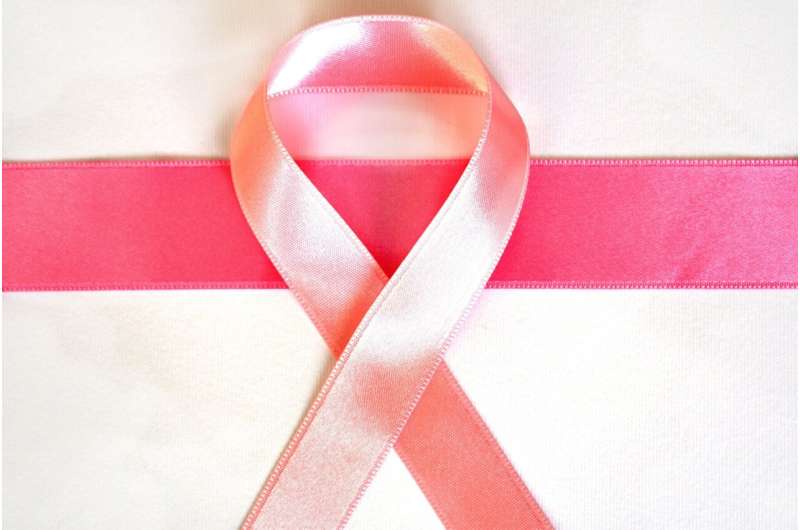This article has been reviewed according to Science X's editorial process and policies. Editors have highlighted the following attributes while ensuring the content's credibility:
fact-checked
reputable news agency
proofread
Breast cancer rises among Asian American and Pacific Islander women

About 11,000 Asian American and Pacific Islander women were diagnosed with breast cancer in 2021 and about 1,500 died. The latest federal data shows the rate of new breast cancer diagnoses in Asian American and Pacific Islander women—a group that once had relatively low rates of diagnosis—is rising much faster than that of many other racial and ethnic groups. The trend is especially sharp among young women such as Kashiwada.
About 55 of every 100,000 Asian American and Pacific Islander women under 50 were diagnosed with breast cancer in 2021, surpassing the rate for Black and Hispanic women and on par with the rate for white women, according to age-adjusted data from the National Institutes of Health. (Hispanic people can be of any race or combination of races but are grouped separately in this data.)
The rate of new breast cancer cases among Asian American and Pacific Islander women under 50 grew by about 52% from 2000 through 2021. Rates for AAPI women 50 to 64 grew 33% and rates for AAPI women 65 and older grew by 43% during that period. By comparison, the rate for women of all ages, races, and ethnicities grew by 3%.
Researchers have picked up on this trend and are racing to find out why it is occurring within this ethnically diverse group. They suspect the answer is complex, ranging from cultural shifts to pressure-filled lifestyles—yet they concede it remains a mystery and difficult for patients and their families to discuss because of cultural differences.
Helen Chew, director of the Clinical Breast Cancer Program at UC Davis Health, said the Asian American diaspora is so broad and diverse that simple explanations for the increase in breast cancer aren't obvious.
"It's a real trend," Chew said, adding that "it is just difficult to tease out exactly why it is. Is it because we're seeing an influx of people who have less access to care? Is it because of many things culturally where they may not want to come in if they see something on their breast?"
There's urgency to solve this mystery because it's costing lives. While women in most ethnic and racial groups are experiencing sharp declines in breast cancer death rates, about 12 of every 100,000 Asian American and Pacific Islander women of any age died from breast cancer in 2023, essentially the same death rate as in 2000, according to age-adjusted, provisional data from the Centers for Disease Control and Prevention. The breast cancer death rate among all women during that period dropped 30%.
The CDC does not break out breast cancer death rates for many different groups of Asian American women, such as those of Chinese or Korean descent. It has, though, begun distinguishing between Asian American women and Pacific Islander women.
Nearly 9,000 Asian American women died from breast cancer from 2018 through 2023, compared with about 500 Native Hawaiian and Pacific Islander women. However, breast cancer death rates were 116% higher among Native Hawaiian and Pacific Islander women than among Asian American women during that period.
Rates of pancreatic, thyroid, colon, and endometrial cancer, along with non-Hodgkin lymphoma rates, have also recently risen significantly among Asian American and Pacific Islander women under 50, NIH data show. Yet breast cancer is much more common among young AAPI women than any of those other types of cancer—especially concerning because young women are more likely to face more aggressive forms of the disease, with high mortality rates.
"We're seeing somewhere almost around a 4% per-year increase," said Scarlett Gomez, a professor and epidemiologist at the University of California-San Francisco's Helen Diller Family Comprehensive Cancer Center. "We're seeing even more than the 4% per-year increase in Asian/Pacific Islander women less than age 50."
Gomez is a lead investigator on a large study exploring the causes of cancer in Asian Americans. She said there is not yet enough research to know what is causing the recent spike in breast cancer. The answer may involve multiple risk factors over a long period of time.
"One of the hypotheses that we're exploring there is the role of stress," she said. "We're asking all sorts of questions about different sources of stress, different coping styles throughout the lifetime."
It's likely not just that there's more screening. "We looked at trends by stage at diagnosis and we are seeing similar rates of increase across all stages of disease," Gomez said.
Veronica Setiawan, a professor and epidemiologist at the Keck School of Medicine of the University of Southern California, said the trend may be related to Asian immigrants adopting some lifestyles that put them at higher risk. Setiawan is a breast cancer survivor who was diagnosed a few years ago at the age of 49.
"Asian women, American women, they become more westernized so they have their puberty younger now—having earlier age at [the first menstrual cycle] is associated with increased risk," said Setiawan, who is working with Gomez on the cancer study. "Maybe giving birth later, we delay childbearing, we don't breastfeed—those are all associated with breast cancer risks."
Moon Chen, a professor at the University of California-Davis and an expert on cancer health disparities, added that only a tiny fraction of NIH funding is devoted to researching cancer among Asian Americans.
Whatever its cause, the trend has created years of anguish for many patients.
2024 KFF Health News. Distributed by Tribune Content Agency, LLC.


















